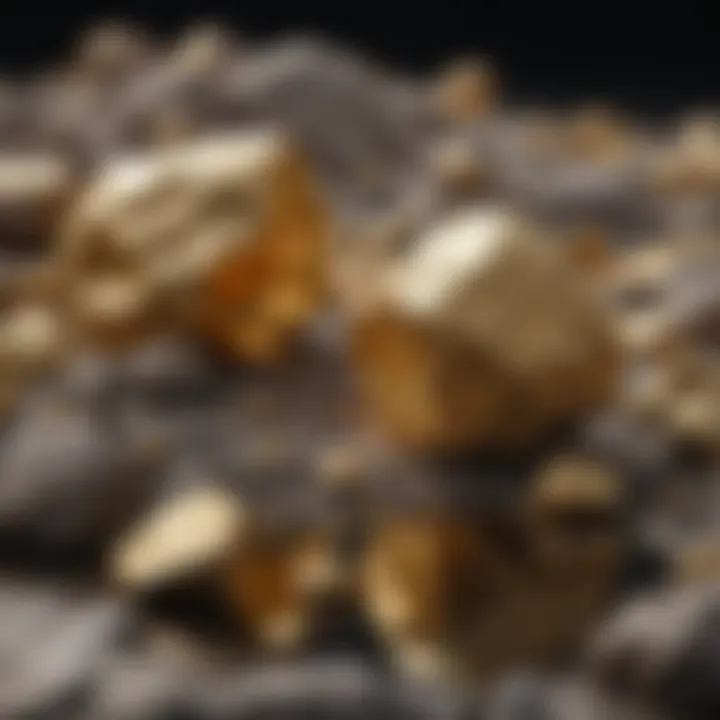Understanding Fool's Gold: The Illusion of Mineral Wealth


Intro
Fool's gold, with its striking resemblance to real gold, has fascinated many throughout history. Known scientifically as iron pyrite, this mineral is often a source of confusion and disappointment for prospectors and collectors alike. Understanding the nature of fool's gold goes beyond mere identification; it delves into the geological processes that create it, its significance in history, and its implications for collectors today. This article examines these facets. We aim to shed light on the allure of fool's gold while presenting a realistic evaluation of its properties and historical context.
History and Origins
Overview of Collectibles, Rocks, and Fossils
The fascination with rocks and minerals dates back centuries. In the realm of collectibles, fool's gold stands out due to its dual identity. On one hand, it is a beautiful specimen admired for its metallic luster and golden hue. On the other, it serves as a reminder of the pitfalls of misidentifying minerals. Collectors often seek fool's gold for its aesthetic appeal and as an educational tool. Understanding its formation can illuminate broader concepts in mineralogy.
Historical Significance and Cultural Impact
Fool's gold has been a source of both hope and frustration. Gold fever in the 19th century often led prospectors to mistakenly believe they had struck it rich when they encountered iron pyrite. This mineral has also appeared in folklore and cultural references, which underline its enduring impact on human history. In many cultures, the shiny appearance of fool's gold led to its incorporation into jewelry and decorative arts, further blurring the lines between wealth and folly. The essence of fool's gold is tied intimately to the human experience of desire and deception in the pursuit of wealth.
Identification and Classification
Guide to Identifying Fool's Gold
Identifying fool's gold can be straightforward if one knows what signs to look for. Here are some key features:
- Color: Typically a bright, brassy yellow.
- Luster: Metallic sheen, often more pronounced than real gold.
- Hardness: Higher than that of gold, which is about 2.5 to 3 on the Mohs scale. Pyrite ranks about 6 to 6.5.
- Streak: A black streak on a porcelain tile can indicate pyrite.
Fool's gold often forms in cubic shapes, a trait that can help differentiate it from the smooth, irregular shapes of gold nuggets.
Common Types and Variations
There are various forms of pyrite, each with distinct characteristics. Examples include:
- Cubic Pyrite: The most recognizable form, often found in distinct cubic crystals.
- Marcasite: A similar mineral that can also be mistaken for fool's gold but has a different crystal structure.
- Pyrite Spheroids: Rounded aggregates of pyrite that might be found in sedimentary rocks.
Each type presents unique features that can enrich a collector's understanding of mineral diversity.
"The quest to differentiate fool's gold from true gold underscores the complexity and beauty of mineralogy."
Through these insights, readers can appreciate not just the allure of fool's gold but also the reality that lies beneath its surface. This engagement with the mineral world opens pathways to deeper knowledge and informed collection practices.
Foreword to Fool's Gold
The topic of fool's gold serves as a crucial foundation for understanding both mineralogy and the economic implications of minerals in general. It is essential not just for collectors but also for enthusiasts and anyone who engages in geological studies. Fool's gold, known scientifically as iron pyrite, is often mistaken for the precious metal gold due to its alluring shimmer and color. The importance of this subject lies in its blend of natural beauty, historical anecdotes, and economic realities.
In this article, we will explore fool's gold from multiple angles, including its definition, chemical properties, geological formation, and identification techniques, as well as its cultural and economic significance. By understanding fool's gold, readers can better appreciate its role as both a fascinating specimen and a cautionary tale in the world of mineral wealth. This exploration will debunk common myths and clarify why some minerals are deceptively similar while being fundamentally different.
Defining Fool's Gold
Fool's gold primarily refers to iron pyrite, a mineral that shares a metallic luster similar to gold. Its distinct brassy yellow hue often leads less experienced mineral collectors to mistakenly identify it as genuine gold. Pyrite's crystal form can vary from cubic to pyritohedral, adding to its unique aesthetic appeal.
The name „fool's gold“ originates from the idea that those who hoped to strike it rich by mining this mineral were sadly mistaken. This term is a reflection of both its deceptive appearance and its lack of any real monetary value in comparison to actual gold. Therefore, accurately defining fool's gold assists collectors and researchers in distinguishing between value-less and valuable mineral specimens.
Chemical Composition and Properties
The chemical formula of fool's gold, FeS2, reveals a composition that consists of iron and sulfur in equal parts. This composition is significant, as the bonding structure leads to its unique properties:
- Color: Fool's gold displays a striking golden-yellow hue, typically brighter than real gold.
- Luster: It has a metallic luster, which may help explain its initial allure to prospectors.
- Hardness: On the Mohs scale, pyrite rates between 6 and 6.5, making it somewhat harder than gold.
- Streak: The streak of fool's gold is typically greenish-black, which sets it apart when tested against real gold's golden streak.
Understanding the chemical properties of fool's gold not only helps in identification but also aids in understanding its formation process and how it interacts with other minerals in natural settings. Thus, recognizing these details is vital for any serious collector or hobbyist.


Geological Formation of Fool's Gold
The geological formation of fool's gold is essential in understanding its characteristics and potential uses. Fool's gold, known scientifically as pyrite, is often found in sedimentary and volcanic rock formations. Understanding its formation can help collectors and enthusiasts appreciate its unique properties while recognizing its limitations.
Origins of Pyrite
Pyrite is composed of iron and sulfur, giving it a distinctive golden sheen that can easily be mistaken for gold. Its formation typically occurs at high temperatures within hydrothermal systems. From these systems, pyrite can crystallize in various forms, including cubic or pyritohedral shapes.
In sedimentary environments, pyrite forms through the process of diagenesis. In this process, organic matter decomposes, creating an anoxic environment in which sulfate ions react with iron to form pyrite. This contrasting formation location impacts the abundance and distribution of fool's gold in various geological contexts.
"Fool's gold can signify more than just a mineral; it reflects the complex processes of earth’s geochemistry."
Environmental Conditions Favoring Formation
The conditions conducive to the formation of fool's gold are multifaceted. Pyrite typically requires:
- Anoxic Environments: Environments with low oxygen levels favor the development of pyrite, as oxidative processes hinder its formation. These conditions are common in swamps or marine sediments.
- Presence of Iron and Sulfur: Abundant iron and sulfur are necessary for pyrite formation. In many geological settings, such as volcanic ash layers or iron-rich sedimentary deposits, these elements are plentiful.
- Temperature and Pressure: Moderate to high temperatures and pressures also play a vital role. Pyrite is often a product of hydrothermal processes in volcanic regions, where the right combination of heat and pressure can alter mineralogy.
- Biological Activity: The role of bacteria in sulfur cycling can contribute to the formation of pyrite. Certain microbes reduce sulfate, making it available for pyrite formation.
Understanding these environmental factors not only aids in identifying fool's gold but also puts its economic value into perspective. While it can be beautiful, one must recognize that it holds limited worth compared to true gold.
Identification Techniques
Identifying fool's gold, or iron pyrite, is crucial for hobbyists and collectors. Misidentifying it as gold can lead to misconceptions about mineral values. Understanding how to discern fool's gold from true gold enhances both collecting and educational experiences. This section will outline the practical techniques used to identify fool's gold effectively.
Visual Characteristics
Fool's gold possesses distinct visual traits that can aid in its identification. It often showcases a metallic luster and a brass-yellow hue. However, the color is not uniform. Pyrite can range from gold-like shades to duller tones, which complicates identification.
Additionally, fool's gold tends to form in cubic crystals, a key visual feature. The crystal structure can be observed under magnification, helping collectors distinguish it from gold, which does not exhibit this formation. A notable quality is the presence of striations on the crystal surface, which are not typically found on gold specimens. Therefore, careful examination of these visual cues is fundamental for accurate identification.
Physical Tests for Differentiation
Physical tests provide more scientific methods to differentiate fool's gold from true gold. Two popular tests are the streak test and hardness comparison.
Streak Test
The streak test involves scratching the mineral across a ceramic plate to reveal its powder color. This is significant because fool's gold leaves a greenish-black streak, while true gold results in a yellow streak. The simplicity of this test makes it popular among collectors. It requires minimal equipment and offers immediate results. However, a limitation arises if the sample is too small or if the mineral surface is polished, possibly affecting the outcome of the test.
Hardness Comparison
Hardness comparison evaluates the resistance of minerals to scratching. Pyrite has a hardness of about 6-6.5 on the Mohs scale, whereas gold is softer, rated at about 2.5-3. This contrast is essential for identifying materials. Using a simple scratch test against glass or another known mineral can provide clarity. The relatively high hardness of pyrite can serve as a telling factor. Although this test is straightforward, it requires careful execution to avoid damaging valuable specimens.
Chemical Tests for Assurance
Chemical tests serve as definitive methods for verifying mineral compositions. Pyrite can be tested with reagents that produce distinct reactions, distinguishing it from gold. For example, using hydrochloric acid results in bubbling with pyrite due to iron oxidation. This type of test is less common among casual collectors due to the need for specific reagents and safety precautions. However, for more serious enthusiasts, it provides a reliable means of confirming identification.
Historical Context of Fool's Gold
The historical significance of fool's gold is more than just an anecdote about miners being tricked by its shiny exterior. It serves as a reflection of human aspirations and economic behaviors. The allure of gold has driven countless individuals to seek wealth, often blinding them to the reality that not all that glitters is actually gold. This mistake has profound implications, both in the past and today. Understanding the historical nuances surrounding fool's gold can provide clarity on its influence in various cultures and during significant periods of geological exploration.
Cultural Relevance
Fool's gold, or iron pyrite, has found its way into various cultural narratives. It symbolizes the unfulfilled promise of wealth. Its bright, metallic luster has captured the imagination of artists, writers, and historians alike. various cultures have misused its deceptive appearance to tell stories of greed and folly. In certain Native American cultures, pyrite was used in rituals, believed to hold protective powers. Literature often references fool's gold as a metaphor for illusory wealth or false hopes.
Additionally, fool's gold has a role in modern commerce, influencing how minerals are marketed. The line between value and deception is often blurred, and this has led to attitudes about investment and economic decisions that echo the mistakes of the past. Collectors and enthusiasts see it not merely as a rock but as a piece of history that carries centuries of stories and lessons. The lasting cultural relevance of fool's gold reminds us of our ongoing struggle to discern between reality and illusion.


Fool's Gold in Prospecting History
The history of fool's gold in prospecting is rich and layered. During the Gold Rush in the mid-19th century, many hopeful prospectors flooded to California, driven by tales of easy fortune. However, many were met with disappointment when what they thought was gold turned out to be iron pyrite. This phenomenon led to a deeper understanding of mineralogy and the differences between genuine gold and fool's gold. As prospectors became more educated, they developed methods to better identify minerals and their properties.
The erroneous findings of fool's gold also prompted advancements in mining techniques and tools. Prospectors learned to use more precise methods for identifying minerals, which eventually contributed to a more scientific approach in geology. The knowledge gained from dealing with fool's gold helped pave the way for successful mining ventures in the future.
Furthermore, fool's gold has served as an illustrative lesson in caution and due diligence within the mining industry. Documents from the era often caution about the potential pitfalls of confusing pyrite for gold. What started as a nuisance for early miners evolved into a substantial part of mineral naming and classification systems.
"Fool's gold is not just a mineral, but a testament to human ambition and error in the face of nature."
Fool's gold's historical context illustrates the relationship between humans and their pursuit of wealth. The lessons learned from its deceptive appearance are still relevant. Recognizing the cultural narratives and the evolution of prospecting techniques helps collectors and enthusiasts appreciate fool's gold on multiple levels. Its storied past offers valuable insights into human attitudes towards wealth, deception, and the enduring quest for understanding in the field of mineralogy.
Economic Implications of Fool's Gold
Exploring the economic implications of fool's gold is crucial for understanding its significance beyond mere aesthetics. Often overlooked, iron pyrite offers insights into mining practices, industrial applications, and market dynamics. These factors shape not just the perceptions of mineral wealth but also the economic landscape surrounding this mineral.
Mining and Extraction Considerations
From a mining perspective, fool's gold presents unique challenges and considerations. Miners often encounter pyrite in regions rich with gold deposits. However, its presence can lead to confusion during the prospecting phase. It is essential to distinguish between pyrite and gold to avoid economic loss and allocate resources efficiently.
Mining companies may need to revise their methods to mitigate deficiencies in their evaluation processes. For example:
- Site Analysis: Careful geological studies can help determine the likelihood of genuine gold deposits versus fool's gold.
- Cutting Down Waste: Effective identification can minimize the costs associated with wasting time and resources on ultimately non-valuable minerals.
The costs associated with improperly identified minerals can affect the overall economics of mining operations significantly. In some instances, mining pyrite can yield sedimentary byproducts that are environmentally friendly, thus promoting sustainability.
Industrial Uses of Pyrite
Fool's gold has diverse industrial applications that might not be widely known. Pyrite is not just a mineral; it serves various practical purposes across several industries. Its properties enhance manufacturing processes and can be harnessed in environmentally conscious manners.
Some notable industrial applications of pyrite include:
- Sulfur Production: Iron pyrite is an important source of sulfur, used in the production of sulfuric acid and fertilizers.
- Electronics Sector: Research suggests potential applications in electronic components due to pyrite's semiconductor properties.
- Cosmetic Sector: The mining and usage of pyrite have found a niche market in cosmetics, primarily for its aesthetic appeal and purported benefits in skincare products.
"The industrial relevance of pyrite demonstrates that even minerals mistakenly categorized as worthless can have significant economic value."
Understanding these economic implications allows collectors and hobbyists to appreciate fool's gold in a new light. The focus shifts from simple mineral admiration to recognizing its role in the broader economic and environmental contexts.
Caring for Fool's Gold Specimens
Caring for fool's gold specimens is crucial for both collectors and enthusiasts. These pieces of pyrite hold not only scientific interest but also aesthetic value. Proper care can significantly enhance their longevity and appearance. In this section, we will explore storage recommendations and cleaning techniques that ensure the integrity of each specimen.
Storage Recommendations
When it comes to storing fool's gold, considerations such as environmental conditions and location play a significant role. Here are some essential tips for effective storage:
- Temperature Control: Keep your specimens in a stable environment, ideally between 65°F to 75°F. Extreme fluctuations can cause deterioration.
- Humidity Levels: Maintain a relative humidity of 40% to 60%. High humidity can lead to oxidation or other damage to the pyrite.
- Use of Display Cases: Acid-free display cases are recommended to protect from dust and air exposure. This can also allow for unobstructed viewing.
- Avoid Direct Sunlight: Sunlight may fade colors or cause unwanted heat. Choose a shaded location for storage.
- Separation from Other Specimens: Prevent scratches by ensuring fool's gold does not come into contact with other mineral samples.
Implementing these recommendations can prevent potential damage and ensure that your specimens remain attractive.
Cleaning Techniques
Occasional cleaning can keep fool's gold specimens looking their best. However, it is crucial to use proper techniques to avoid harm. Here are some recommended cleaning methods:
- Gentle Brush: Use a soft brush to remove dust and loose particles. Avoid hard bristles that may scratch the surface.
- Water and Soap: If further cleaning is necessary, mix a small amount of mild dish soap with water. Dip the brush into the soapy solution and gently clean the specimen. Do not soak the pyrite, as this might cause damage.
- Rinse Carefully: After cleaning, use distilled water to rinse off soap residue. Ensure the specimen is not left in contact with water for too long.
- Pat Dry: Use a soft, lint-free cloth to carefully pat the specimen dry. Avoid any rough materials that could leave scratches.


"The value of fool's gold increases with proper care and maintenance, reflecting both dedication and respect for geological history."
Following these cleaning techniques will help maintain the appearance and longevity of fool's gold specimens. Successful care ultimately allows collectors to fully appreciate the unique qualities of pyrite.
Fool's Gold vs True Gold
Fool's gold presents a deceptive challenge, especially for rock and fossil collectors. Its similarity to real gold can create misconceptions about value and composition. Understanding the differences between fool's gold, or iron pyrite, and true gold is crucial for collectors and anyone interested in geology.
Comparative Value Analysis
The value of fool's gold and true gold diverges significantly. True gold holds intrinsic value as a precious metal, commonly used in jewelry and finance. In contrast, fool's gold, although aesthetically pleasing, does not possess the same level of economic value.
- Gold Price: Real gold prices fluctuate based on market demands, geopolitical stability, and economic factors. The price of gold per ounce is often cited in financial news, reflecting its status as a hedge against inflation.
- Fool's Gold: Conversely, fool's gold has little to no monetary value in standard markets. While it can appeal to collectors for its visual qualities, it does not command the same prices as gold. Its presence in mineral collections does not equate to a significant financial investment.
Moreover, fool's gold sometimes serves as a teaching tool within geology, helping to instruct individuals on mineral identification and economic mineralogy. It highlights the importance of proper identification in mineral collections, preventing costly mistakes.
Market Trends and Demand
Current market trends indicate that true gold remains in high demand, primarily driven by investment opportunities and cultural significance. Gold's allure is perennial, with collectors and investors seeking tangible assets. This trend emphasizes the enduring appeal of gold as a store of value.
Fool's gold, while not economically impactful, sees varying degrees of interest within niche markets. Rock and mineral shows often feature pyrite, attracting hobbyists and collectors eager to acquire unique specimens. The demand for aesthetic specimens has increased as enthusiasts appreciate the beauty of iron pyrite in natural settings.
- Collectors' Interests: Some collectors especially focus on pyrite due to its crystal formations and luster, making it sought after in display cases.
- Educational Use: Educational institutions often use fool's gold for teaching mineral properties, further sustaining its relevance in mineralogy, though this is distinct from true financial value.
Fool's Gold in Modern Science
The study of fool's gold, or iron pyrite, extends far beyond its conventional understanding as a mere counterfeit of true gold. From its unique chemical properties to its significance in various fields, fool's gold holds value in modern scientific research. This section examines the contemporary applications of pyrite and its role in environmental studies. This knowledge is essential for collectors as it connects their passion with ongoing scientific endeavors.
Research on Pyrite Applications
Iron pyrite is more than just a pretty mineral; it has a multitude of applications that scientists and researchers are excited about. One of the most promising uses is in the field of renewable energy. Pyrite can serve as a photocatalyst in solar energy systems. Its band gap properties allow it to absorb sunlight efficiently, potentially contributing to the development of more effective solar panels.
- Pyrite can also play a part in generating hydrogen fuel through water splitting, an important area for sustainable energy solutions.
- Additionally, some researchers are investigating its application in batteries, particularly lithium-sulfur batteries. Pyrite may enhance performance, making it a candidate for advanced storage technologies.
Notably, the accessibility and natural abundance of pyrite make it a cost-effective alternative compared to rare materials. The ongoing research is vital for reducing dependency on less sustainable resources and fostering eco-friendly technologies.
Role in Environmental Studies
Fool's gold has gained traction in environmental science, especially regarding its implications in pollution and mine waste management. Its characteristics make it integral in assessing the environmental impact of mining activities.
- Pyrite oxidation produces acids, which can leach metals into waterways, causing significant ecological harm. Understanding this process is crucial for developing strategies to mitigate acid mine drainage.
- Furthermore, researchers are exploring pyrite's capability to stabilize contaminants, making it a potential tool in remediating polluted sites.
The study of pyrite's role in the environment illustrates the balance between mineral extraction and ecological preservation. It challenges the notion of fool's gold as merely waste; rather, it positions it as a subject of serious scientific inquiry, with potential benefits and applications.
"Fool's gold is not a fool's errand in science; its examination may lead us to critical advancements in sustainability and resourcefulness."
Epilogue
The conclusion serves as a vital summation of the themes explored in the previous sections. It encapsulates the multifaceted nature of fool's gold, which, despite its deceptive appearance, holds unique significance in both mineralogy and economic geology. Understanding fool's gold is not just about recognizing its physical characteristics or its historical context. It extends to the implications for collectors and enthusiasts who might encounter this mineral in their pursuits.
Summarizing Key Points
The exploration of fool’s gold encompasses numerous critical points:
- Deceptive Appearance: Fool's gold, or iron pyrite, is often confused with true gold because of its shiny, metallic luster. This confusion can lead to misjudgments in investment and collection.
- Geological Origins: Its formation and the environmental conditions that favor its development provide insight into how different minerals coexist and interact in nature.
- Identification Techniques: Knowing how to properly identify fool’s gold through visual characteristics, hardness tests, and streak tests can prevent costly mistakes in the field.
- Historical Significance: The cultural and prospecting history related to fool’s gold enriches our understanding of human perception towards natural resources.
- Economic Consideration: While fool’s gold does not hold the same value as gold, it does have industrial uses. This duality adds depth to its economic relevance.
Future Perspectives on Fool's Gold
Looking forward, the future perspectives on fool's gold are promising. Research continues to uncover new applications for pyrite in various fields, particularly in technology and environmental studies. Innovations in mining practices could also enhance the extraction of iron pyrite, making it more economically viable. As interests in geology and mineralogy grow, fool’s gold is likely to remain a subject of fascination among collectors and scientists alike.
"Fool's gold may lack the financial allure of true gold, but its scientific significance and industrial potential cannot be overlooked."
Through this article, we recognize that fool's gold extends beyond its superficial charm. Its place in the natural world and within the context of human understanding offers myriad opportunities for further exploration and appreciation.



